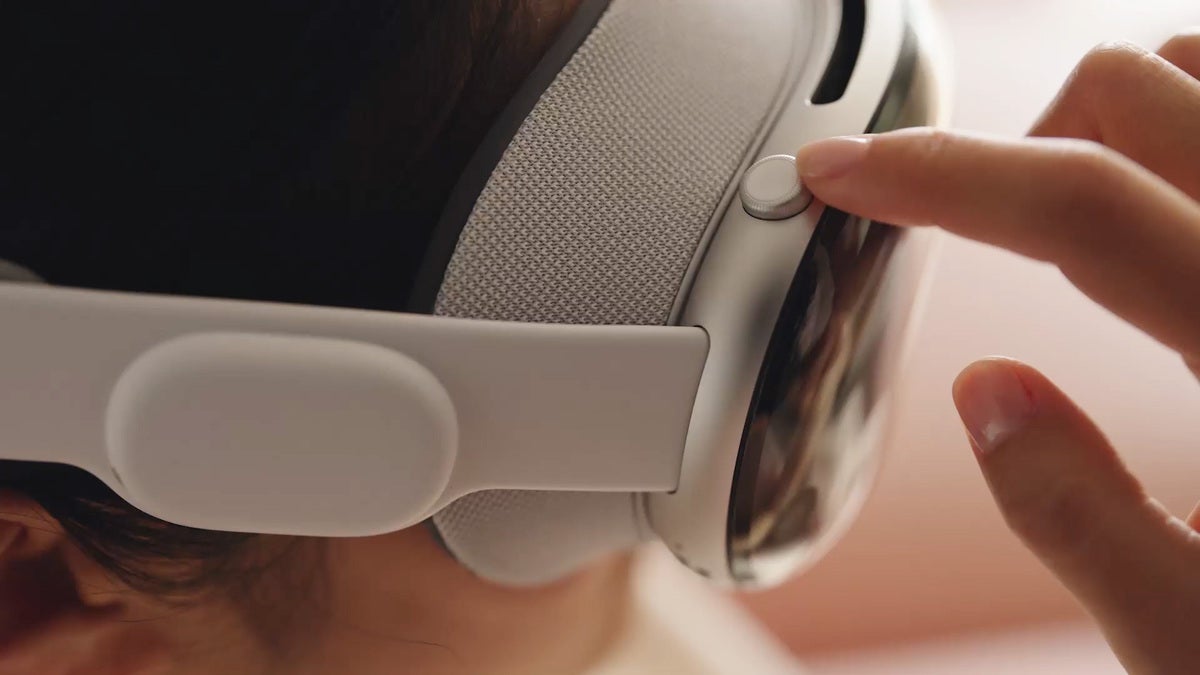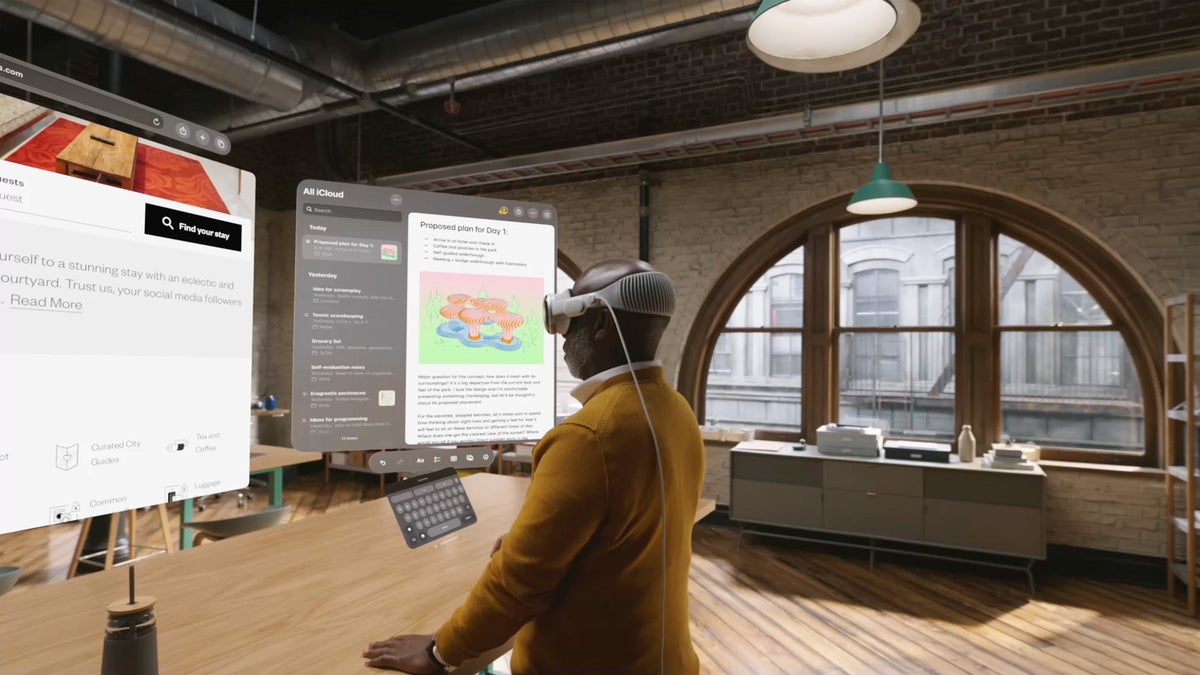Tomorrow belongs to somebody, but Apple’s much-talked-about mixed-reality device, Vision Pro — unveiled Monday during a glitzy presentation at the company's Worldwide Developers Conference — won’t ship until early 2024. And at $3,499 a pop, each one costs the same as several Meta Quest systems.
There's absolutely no denying that the technology used in the Vision Pro is super-sophisticated; these systems truly are, as Apple said, “the most advanced personal electronics devices ever.”
“Today marks the beginning of a new era for computing,” said Apple CEO Tim Cook. “Just as the Mac introduced us to personal computing, and iPhone introduced us to mobile computing, Apple Vision Pro introduces us to spatial computing."
With a nod to his predecessor, Steve Jobs, Cook announced the Vision Pro after promising "one more thing."
Take a moment to consider just some of the innovation Apple has pulled together in one device.
- Powerful Apple processors that reflect years of development, including a brand new R1 chip to handle sensor data.
- Highly evolved user interface technologies that rely on touch, glance, and voice, which reflect UI development across the last 50 years.
- An extensive development environment Apple has been building toward for years.
- Support from a cohesive assemblage of applications and an orchard of third-party apps from Day One.
- A profoundly hard-to-match collection of sensors, materials science, and displays developed across the last decade or two.
- And two-hour battery life when not plugged in. <Insert record scratch sound.>
That battery life is a real vulnerability in these systems. After all, while you can safely use them plugged into power (I hope) the beauty of the pervasive computing system Vision Pro promises to provide is that you can move around in your physical life while remaining connected to your digital one. Think about home workers, warehouse operators, medical, emergency services and others….
(If you do need lenses to be popped inside these things because you have poor vision, “vision correction accessories are sold separately.")
But if you need to be connected to electricity when using Apple’s goggles for extended lengths of time, what's the advantage in comparison to using an iPhone, iPad, or Mac? All give you an entire working day on a single battery charge.
Of course, everyone’s a critic, and while there are easy-to-spot weak points that probably reflect the internal discussions that have reportedly already taken place at Apple in recent months and years, there are also strong points.
Apple’s new world
In this new world of spatial computing, apps, computing, ambient intelligence, and all manner of entertainment are simply a tweak on the Digital Crown away. This spatial computer blends real experience with digital content. It gives you the world’s biggest display experience, tens of thousands of apps, and it turns computing into a pervasive environment you can share with others who have a set of these things, while giving your family a virtualized glimpse at your eyes.
To its credit, the company spent a lot of time thinking about how to design and build geeky googles that more or less get out of the way. “Apple Vision Pro also features EyeSight, an extraordinary innovation that helps users stay connected with those around them,” Apple said in statement, explaining:
“When a person approaches someone wearing Vision Pro, the device feels transparent — letting the user see them while also displaying the user’s eyes. When a user is immersed in an environment or using an app, EyeSight gives visual cues to others about what the user is focused on.”
 Apple
Apple
The Digital Crown on Apple's Vision Pro.
Apple in the pervasive enterprise
But, beyond relatively well off tech-savvy singletons sleeping alone in empty homes, who are these things for? It's undeniable there’s a nascent market. There are people for whom this kind of tech will be personally life changing. There are numerous professions (health, security, warehousing, field service engineering, sales, emergency, military, and more) in which this kind of ambient computing experience, coupled with an insanely great development environment, makes great sense.
It is interesting that Apple put so much energy during the big rollout into enterprise deployment.
“Look at the way Apple presented this, breaking away first to the ways organizations can utilize this incredible new technology,” Jamf CEO Dean Hager said. "When has Apple ever presented the ‘enterprise’ use case before the personal use case? Vision Pro is very exciting for the enterprise, and holds endless possibility for improving organizational outcomes."
All of which begs the question.
Amazing tech, but who is it for?
Then there is the technology argument.
There's so much innovation here: you can wear Vision Pro to experience virtual or augmented environments up to 23 million pixels big; create an infinite canvas on which to get things done; turn on a portable cinema with a 100-foot screen; use a 3D camera to take spatial photos (imagine this in use by news photographers). With the twist of the Digital Crown, you can leave behind your own grim, gray reality of punitive credit card debt following your $3,499 tech investment into a virtual world occupied by dinosaurs and a giant Ted Lasso.
Believe!
Sarcasm aside, it's crystal clear that teams across Apple have been busily focused on making something fabulous here. Apple being Apple, you must also accept that we don’t have the entire story yet — what these things can do, or at least what we are told they can do, will continue to develop over time. In fact, we can expect some application surprises and even more OS tweaks before they ship.
This is a road for Apple, and new ideas like these need to evolve.
Time to grow in
Time is the critical factor here.
It’s really unwise to judge these products on what we’ve just been told; it’s also important, maybe more so, to consider where they're going. What we have right now may be a highly advanced wearable system festooned with useful features that can change the way we work and play (subject to battery life and the resilience of the “supple” power cable supplied), but where we are going is something else.
Apple will refine the operating system and design; it will reduce the price and seek to identify the most popular use cases for these systems. While it does feel plausible that the product may not yet meet the overall vision of the company, and while it may be restricted by the technology available today, tomorrow is a different day. Apple will invent toward it.
For most people now, today, this isn’t an investment they need to make. But enterprise users, developers, and technologists will want to find out more. They must.
Apple is defining a new computing paradigm. “It would be drastic to say that Apple Vision Pro will replace a computer or cellphone in the immediate future,” VRdirect CEO, Rolf Illenberger said in a statement.
“But that day will happen soon (most likely starting with those who enjoy having a second or third monitor at their workstations). This announcement serves as a welcome bridge into the world of AR and VR by a company known for creating seamless, reliable, and integrated technology.”
Several more things
Lost in the hubbub over Vision Pro were a slew of other noteable announcements (more to come on these over the next few days). Apple introduced a variety of super-powered new Macs, including a 15-in. MacBook Air, an updated Mac Studio, and — at last — a new Apple Silicon Mac Pro. It touted new operating systems, privacy features and explained how in the future you’ll be able to ask your iPhone where to find the remote control for your Apple TV.
Who says the 21st century hasn't arrived?
It is perhaps noteworthy that Apple Silicon played second fiddle to the biggest announcements, even as the capabilities of its new M2 Ultra processor completely reset expectations of PCs. Need 192GB of memory in your Mac? I can recall when the most you could expect was 16GB. Vision Pro, or otherwise, Apple’s overall computing ecosystem took a big step forward today.
But it’s going to need a little time to prove itself.
Please follow me on Mastodon, or join me in the AppleHolic’s bar & grill and Apple Discussions groups on MeWe.






